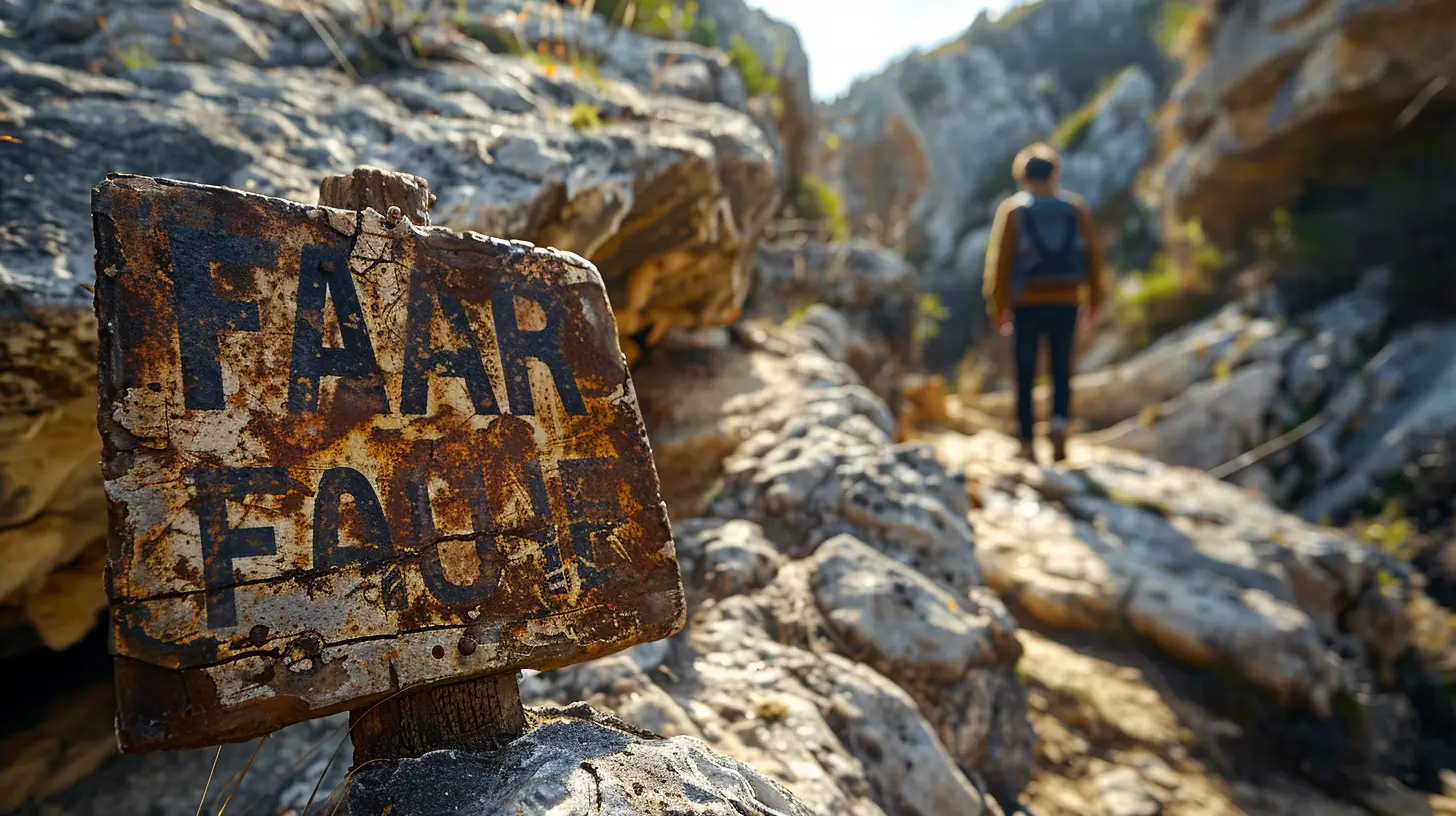The Role of Fear in Risk-Taking Behavior
16 September 2025
Fear. It's that gut-punch feeling we get when something feels off. Our heart races, our palms sweat, and our mind screams, “Danger ahead!” But believe it or not, fear isn't just here to freak us out—it actually plays a huge role in how we evaluate risks and make decisions.
Let’s be real for a second—every big move we make in life involves some level of risk, right? Whether it's changing careers, starting a business, moving to a new city, or even just talking to someone new, there’s always that voice in our head whispering… “What if this goes wrong?” That’s fear chiming in. And depending on how much space you give that voice, it can either steer you away from danger or keep you stuck in neutral when you should be hitting the gas.
In this article, we’re diving deep into how fear impacts risk-taking behavior. We’ll break down the psychology behind it, why we sometimes freeze up, what separates the risk-takers from the cautious crowd, and how to strike a healthy balance.
What Exactly Is Fear?
So, let’s start from the top. Fear is an emotional response to a perceived threat. That’s right—perceived. The threat doesn’t have to be real or immediate. It just has to feel real to you.This feeling kicks off your body's “fight-or-flight” response. That’s your brain’s way of preparing you to either face the threat or run like the wind. It's been keeping humans alive for ages, but here’s the twist—fear doesn’t just show up when you’re in physical danger. It also pops up in emotional, financial, and social situations.
Ever felt terrified before making a big life decision? That’s fear doing its thing.
The Brain on Fear: A Peek Under the Hood
Let’s geek out for a sec. The amygdala is the part of your brain that processes fear. Think of it as your internal alarm system. When you sense danger, your amygdala sends out signals that trigger an immediate response.But here's where it gets interesting: the prefrontal cortex—another part of your brain—helps you think through your actions logically. It weighs the pros and cons. The problem? When fear takes over, it can overpower the prefrontal cortex, making rational thought harder.
So, if you’ve ever backed out of something you logically knew was good for you, blame that brain tug-of-war. Your emotional brain screamed louder than your logical one.
Risk-Taking and Fear: A Complicated Relationship
You’d think fear always makes people avoid risks. But it’s not that black and white. Fear doesn’t always stop risk-taking—it shapes it. Sometimes it fuels bold decisions, and other times it slams the brakes.Let’s break this down:
1. Fear As a Risk Reducer
For many people, fear keeps them grounded. It’s that internal warning system that says, “Hey, maybe quitting your job without a backup plan isn’t the best idea.” It forces you to think twice, plan better, and make safer choices.In everyday life, this kind of fear might stop someone from driving too fast, skipping a helmet on a motorcycle ride, or investing money in sketchy ventures.
In short, this is the useful flavor of fear—the one that keeps you alive and out of trouble.
2. Fear As a Motivation Booster
On the flip side, some people use fear as motivation. Ever been terrified to fail, but that same fear pushed you to work ten times harder? That’s fear lighting a fire under you.Athletes, entrepreneurs, performers—they often feel intense fear before taking a leap, but they channel it. Instead of letting it paralyze them, they let it energize their decision-making.
In this case, fear doesn’t reduce risk-taking—it sharpens it.
3. Fear As a Paralyzer
Then, there's the dark side of fear. When it becomes too overwhelming, it can literally freeze you. You overthink every worst-case scenario, get stuck in analysis paralysis, and end up doing nothing at all.This version of fear is like a fog that clouds your judgment and kills momentum. And yeah, it’s tough to break through.
Why Some People Embrace Risk (And Others Avoid It)
Ever wonder why some folks seem fearless while others overthink making a phone call?Here’s why:
Personality Traits
Some people are just wired to seek out new and intense experiences. Psychologists call this “sensation-seeking.” These people often take risks because they love the thrill.On the flip side, folks high in anxiety or neuroticism are more likely to play it safe. They tend to feel more intense fear and respond by avoiding risk altogether.
Past Experiences
Our brains are heavily shaped by experience. If you took a risk once and it ended in disaster, your brain remembers that pain. Tough breakups, failed businesses, public embarrassment—it all stacks up and makes you hesitant the next time around.But if a risk led to reward? You’re more likely to take a similar leap again.
Environment and Culture
Cultural values can either encourage or discourage risk-taking. In some cultures, stepping out of line or failing publicly is a major no-no. That type of environment naturally breeds fear of taking chances.Even your family plays a role. If you grew up in a household that valued safety and stability, you might be conditioned to avoid unnecessary risks—even if part of you craves adventure.
The Biology Behind It: Risk, Reward, and the Brain
Let’s get a little nerdy again. When you take a risk, your brain kicks into prediction mode: “What will I get from this?” This involves the brain’s reward system, particularly dopamine—the feel-good chemical.If you perceive the potential rewards as greater than the risks, dopamine floods the brain, nudging you to go for it.
But if fear clouds your judgment, the risk suddenly seems more dangerous than it really is. That dopamine wave gets interrupted—and you back away.
So basically, you’re doing a mental cost-benefit analysis every time you face a risky decision. And fear? That’s the part of the calculator that screams “ERROR” when it sees too many unknown variables.
How Much Fear Is Too Much?
Here’s the thing—some fear is good. It's your body’s natural filter. But too much of it? That’s when it becomes a problem.When fear becomes chronic—always bubbling just beneath the surface—it can lead to anxiety disorders or phobias. And that seriously hinders risk-taking, even when it could lead to growth.
The key is learning to recognize when fear is protecting you and when it’s holding you hostage.
Balancing Fear and Risk: Is It Even Possible?
Yes, absolutely. You can train yourself to respond differently to fear. Here’s how:1. Name It
Sounds simple, but just naming the fear helps. Say it out loud or write it down: “I’m afraid of failing in front of others.” By identifying it, you give it shape—and once you can see it, you can deal with it.2. Challenge the Story
Fear loves to tell you stories. “If I speak up, I’ll look stupid. Nobody will take me seriously.” Challenge that stuff. Ask yourself: “Is that really true? What’s the worst that could actually happen?”Most fears crack under the pressure of logic.
3. Take Micro-Risks
You don’t have to jump off a cliff (figuratively or literally) to face your fears. Start small. Make a bold phone call. Try something new. Ask for feedback.The more you expose yourself to uncertainty, the more comfortable you get with it.
4. Reframe Fear
Instead of seeing fear as the enemy, treat it like a signal. It’s not saying “don’t”—it’s saying “pay attention.” Use that energy to think critically, not panic blindly.Final Thoughts
Fear is complicated. It’s wired deep into our brains, and it impacts nearly every decision we make—especially when it comes to taking risks.But it doesn’t have to control you. In fact, when used the right way, fear can actually help you make smarter, bolder decisions. It can push you to succeed, keep you from making stupid mistakes, and keep life interesting.
So the next time fear shows up, don’t fight it. Listen to it. Learn from it. Then choose whether it’s worth pushing past or pumping the brakes. Because at the end of the day, the goal isn’t to be fearless—it’s to fear less.
all images in this post were generated using AI tools
Category:
Psychology Of FearAuthor:

Nina Reilly
Discussion
rate this article
1 comments
Ashley McLean
Ah, fear—the ultimate motivational speaker! Who knew risking it all could come with a side of heart-pounding panic? So inspiring!
September 26, 2025 at 3:48 AM

Nina Reilly
Thank you for your insightful comment! Fear certainly adds a unique layer to risk-taking, motivating us in unexpected ways.


